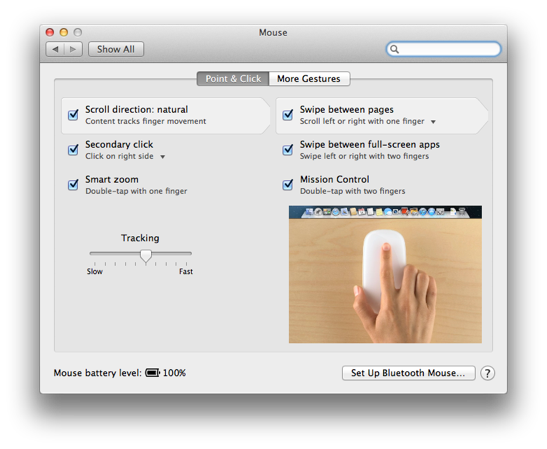Thirty years ago, Apple brought the mouse the masses. Now, the multitouch interface replaces the mouse with your fingers.
There’s nothing quite like reaching out and touching something. Why should your computer be any different? Between the iPhone, iPad and the 80% of Macs that are laptops, less than 3% of today’s Apple devices come with a mouse. Although you can still use a mouse with a Mac, modern Mac software is optimized for a trackpad. Apple is leaving the mouse behind. And you can, too – with a little practice.
Adjust your trackpad & mouse options in System Preferences, which you’ll find in the Apple menu. Practice them – you’ll use them every day. Click the Apple menu and choose System Preferences, then click Trackpad or Mouse. You’ll see the same short video clips demonstrating each gesture and you can customize them yourself.
Basic trackpad gestures to get you started
- Swipe with one finger to move the pointer on the screen.
- Click with one finger for regular selections, or double-tap to open a file.
- Tap with two fingers to bring up options for the object you selected (correct spellings, definitions, colors, etc.).
- Swipe with two fingers to scroll up or down. The area under the pointer moves the same direction as your fingers.
- Pinch two fingers together to zoom out; move them apart to zoom in.
- Rotate two fingers to turn a picture in Photos.
Advanced trackpad gestures
- Tap with three fingers to look up a word in the dictionary.
- Double-tap with two fingers for smart zoom. The text block under the pointer is enlarged to fill the screen.
- Swipe left or right with two fingers to go back or forward. This applies on web pages, in iPhoto and many other apps.
- Swipe left or right with three fingers to move between full-screen apps.
- Swipe up with three fingers for Mission Control to see all your open windows at once.
- Swipe down with three fingers to see just the current app's windows.
- Flick four fingers apart to move windows out of the way and reveal the desktop.
- Draw four fingers together for the Launchpad.
Apple uses “natural scrolling.” When you swipe your finger up, text moves up; swipe down and it goes down. Makes sense, right? Actually it’s the opposite of scrolling on old-style mice. It takes a bit to get used to but after a while it’s much more intuitive.
Force Click gestures
Many Apple laptops made in 2015 or later have a new kind of trackpad. It senses the amount of pressure you apply to the surface and determines whether you’re dragging, clicking, or performing a new function: Force Click. When you point to an object on the screen and press harder, it’s like right-clicking (or control-clicking). So point to a file or website link, press hard and you’ll see a preview of it… without leaving where you are. Force-click on a word to see a definition. Force-click on a date to add an event to your calendar. Force Click is only available on newer trackpads, and the Magic Trackpad 2. Learn more about Force Click.
Magic Mouse
While trackpads and a touch interface are certainly the future, a mouse still has its place. Here’s how to make the most of the Apple Magic Mouse.
- Move the mouse on the desktop to move the pointer on the screen.
- Click on the left half for regular selections, or double-click to open a file.
- Click on the right half to bring up options for the object you selected (correct spellings, definitions, colors, etc.).
- Swipe a finger up or down on the surface of the mouse to scroll. The area under the pointer moves the same direction as your finger.
- Swipe left or right to go back or forward. This applies on web pages, in iPhoto and many other apps.
- Double-tap with two fingers for Mission Control to see all your open windows at once.
Does your mouse seem to have a mind of its own, scrolling and changing views when you least expect it? Because the entire surface is touch-sensitive, it responds to every action your fingers make. It’s OK to grasp the sides of the mouse but avoid resting your fingers on the top surface. Click, drag and swipe carefully, then remove your finger.
If you must, you can use any old-style USB mouse with your Mac but you'll miss out on the multitouch features and all the advancements Apple has made in the past 10 years.
Recommended trackpad & mouse settings
Adjust your trackpad & mouse options in System Preferences. We recommend turning on all options except trackpad three-finger drag. For illustration purposes, we're showing all options together. You’ll need to click More Gestures to see them all on your Mac.

Having trouble connecting your device to work? Learn how to pair a keyboard, mouse or trackpad with your Mac.